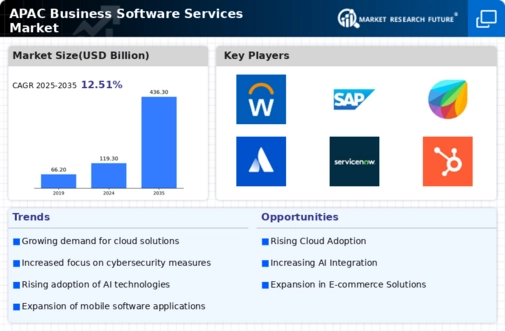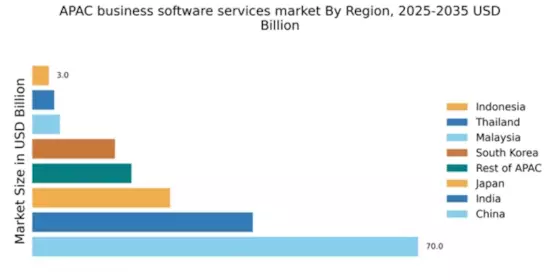Growing Focus on Data Analytics
The business software-services market in APAC is characterized by a growing focus on data analytics. Organizations are recognizing the value of data-driven decision-making, leading to a heightened demand for analytics software that can provide actionable insights. Recent surveys suggest that over 60% of businesses in the region are investing in data analytics tools to enhance operational efficiency and customer engagement. This trend is particularly pronounced in sectors such as retail and finance, where understanding consumer behavior is crucial. As companies strive to leverage big data, the business software-services market in APAC is likely to expand, with a variety of solutions emerging to cater to the analytics needs of diverse industries.
Expansion of E-commerce Platforms
The business software-services market in APAC is influenced by the rapid expansion of e-commerce platforms. With the region witnessing a remarkable increase in online shopping, businesses are increasingly seeking software solutions that can enhance their e-commerce capabilities. Recent statistics indicate that e-commerce sales in APAC are projected to reach $3 trillion by 2025, prompting companies to invest in integrated software services that streamline operations, manage inventory, and enhance customer experiences. This trend is particularly evident in countries like China and India, where digital payment solutions and logistics management software are in high demand. As a result, the business software-services market in APAC is likely to see a surge in innovative solutions tailored to meet the evolving needs of e-commerce businesses.
Rising Demand for Remote Work Solutions
The business software-services market in APAC is experiencing a surge in demand for remote work solutions. This trend is driven by the increasing number of organizations adopting flexible work arrangements. According to recent data, approximately 70% of companies in the region have implemented remote work policies, necessitating robust software solutions to facilitate collaboration and productivity. As businesses seek to maintain operational efficiency, the demand for cloud-based tools, project management software, and communication platforms is likely to grow. This shift not only enhances employee satisfaction but also reduces overhead costs, making it a strategic priority for many organizations. Consequently, the business software-services market in APAC is poised for significant growth as companies invest in technologies that support remote work environments.
Emphasis on Regulatory Compliance Solutions
The business software-services market in APAC is shaped by the emphasis on regulatory compliance solutions. As governments in the region implement stricter regulations across various industries, businesses are compelled to adopt software services that ensure compliance with legal standards. Recent data indicates that compliance-related software spending is projected to grow by 15% annually in APAC. This trend is particularly relevant in sectors such as finance and healthcare, where adherence to regulations is critical. Consequently, the business software-services market in APAC is likely to see a surge in demand for solutions that facilitate compliance management, risk assessment, and reporting.
Increased Investment in Digital Transformation
The business software-services market in APAC is witnessing an increase in investment aimed at digital transformation initiatives. Organizations are recognizing the necessity of adopting advanced technologies to remain competitive in a rapidly evolving landscape. Recent reports indicate that spending on digital transformation in the region is expected to exceed $500 billion by 2025. This investment encompasses a wide range of software services, including cloud computing, artificial intelligence, and customer relationship management systems. As businesses prioritize modernization, the demand for innovative software solutions is likely to rise, driving growth in the business software-services market in APAC.


















Leave a Comment